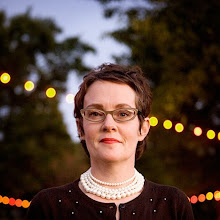
The Poor Farm, friends out front. All pictures by the author.
I spent the last weekend of my Milwaukee vacation with partner Kevin J. Miyazaki (see his blog post), friends Mary Louise Schumacher (her post) and Diane Bacha (her blog), Ken Hanson and John Koethe up in the Waupaca, Wisconsin area to attend the opening weekend of The Poor Farm, an art / educational laboratory by Chicago-based artists Michelle Grabner and Brad Killam.
The three floors (and several projects outside, which I didn't see because of the frightful mosquito quotient) featured a series of artist projects, poetic meditations and mini-surveys of the work of Moira Roth, a much-honored art historian who has chronicled and participated in the feverish events of the American avant garde since the 1960s.

Michelle Grabner and Moira Roth, with knitting chair by Modesto Covarrubias, The Knitter, 2007-2010, behind.
We were lucky to walk through the spaces with Moira to understand the conceptual rooms of her mind and career, seeing how the seemingly-disparate artist projects reflected a disciplined and curious art historian's work.

Poems by Moira Roth, pictures by Slobodan Dan Paich.
I had most recently read Moira's work when doing a project with Nancy Spero, but hers is a career that has influenced countless generations of artists and art historians looking to make sense of the world through art.

History room.
One of the recently cleaned-up upstairs rooms of the 8,000 square foot former farm for the indigent (then a retirement home) housed a set of overlapping, intertwined history that feminist historians like Roth brought to legitimacy in the arts.
Books and texts focused on the 80th birthday of African-American artist Faith Ringgold; documents by Mary Jane Jacob and Russell Lewis on the Women's Building in Chicago, 1893; 19th century African-American history ranging from the tale of escaped slave Caroline Quarlls (who took the underground railroad to Wisconsin, a free state) to W.E.B. Du Bois; to a scattering of documents on the history of Native Americans in Wisconsin.
Roth, Jacobs and Linda Nochlin (who wrote a lovely poem about not being able to make it to Waupaca), are pioneers in a multi-layered multiculturalism which is at the heart of my curatorial practice.
The quiet, meditative quality of the weekend was underscored by the pleasure of lounging around outside drinking Veuve Cliquot and talking with really smart artists, art historians, poets and designers. Wisconsin is a great laboratory these days.




No comments:
Post a Comment